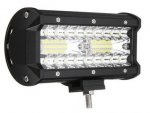So realizing the factory cab lights do not shine where I want them, I have ordered a set of led replacements. I‘ve used quite a few different pods and bars on sidexsides and boats over the past few years. But this is the first time using them for a tractor and discovered something a little odd. most of the pods I’ve used have been 18-30 watts, so amp draw was never a concern. However, these are stated as 120 watt each. I’ve tested them and they are plenty bright and the pattern is great with the flood/spot combination. But measuring the actual amp draw, they are only pulling 3 amps at 12 volts. If they were in fact 120 watt, they should be 10 amp draw. I’m not disappointed, in fact I’m pretty happy the power draw is less which means I can actually use the factory wiring and switch with them instead of having to use a new wiring harness with switch and relay like I originally planned.
I guess my question is, are most led bars rated at actual power consumption or are they under driven so they get more hours of use and are actually far less than advertised? Each light has a 3 watt led with each light containing 40 leds. These are the cheaper eBay/Amazon 7 inch spot/flood combustion lights. ive had good luck with them in past, so I am not concerned with the quality, but I have never had the need to actually measure the amp draw. they do list them as 120 watt, not 120 watt equivalent. Even stating 12000 lumens of light. Again, not disappointed in the performance as they are super bright and have a really wide pattern. Just curious as to others experiences.
I guess my question is, are most led bars rated at actual power consumption or are they under driven so they get more hours of use and are actually far less than advertised? Each light has a 3 watt led with each light containing 40 leds. These are the cheaper eBay/Amazon 7 inch spot/flood combustion lights. ive had good luck with them in past, so I am not concerned with the quality, but I have never had the need to actually measure the amp draw. they do list them as 120 watt, not 120 watt equivalent. Even stating 12000 lumens of light. Again, not disappointed in the performance as they are super bright and have a really wide pattern. Just curious as to others experiences.



